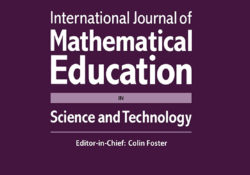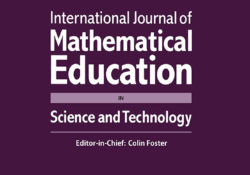tandfonline.com har udgivet en rapport under søgningen “Teacher Education Mathematics”: Signalling playfulness: disguising work as play in the early years’ classroom Link til kilde
Like this:
Like Loading...
tandfonline.com har udgivet en rapport under søgningen “Teacher Education Mathematics”: ‘I loved exploring a new dimension of reality’ – a case study of middle-school girls encountering Einsteinian physics in the classroom Link til kilde
Like this:
Like Loading...
tandfonline.com har udgivet en rapport under søgningen “Teacher Education Mathematics”: High school student perspectives on flipped classroom learning Link til kilde
Like this:
Like Loading...
tandfonline.com har udgivet en rapport under søgningen “Teacher Education Mathematics”: Using a lecture-oriented flipped classroom in a proof-oriented advanced mathematics course Link til kilde
Like this:
Like Loading...
tandfonline.com har udgivet en rapport under søgningen “Teacher Education Mathematics”: Crossover of burnout in the classroom – Is teacher exhaustion transmitted to students? Link til kilde
Like this:
Like Loading...
tandfonline.com har udgivet en rapport under søgningen “Teacher Education Mathematics”: Abstract In this study we aim to characterize a way of proving which can be produced in a primary mathematics classroom and explore the factors that influence these processes and lead to changes in the way of proving. Assuming proving as a socially embedded activity, we conceptualize it as the interplay between ‘construction’ and ‘substantiation’ based on a well-established theoretical framework in mathematics education: the commognitive framework. A tangible proving task was designed, based on the idea of operative proofs, and implemented in a fifth-grade classroom in England. We analysed the construction and substantiation which fairly associated with discursive features (word use, visual mediator, narrative, and routine) during the proving process. The results show that the interplay between construction and… Continue Reading →
Like this:
Like Loading...
tandfonline.com har udgivet en rapport under søgningen “Teacher Education Mathematics”: Abstract Abstract It has previously been suggested that there is a need for a more language focused science instruction, especially in linguistically diverse classrooms, where many students are second language learners. But it has also been suggested that teachers may feel uncertainty about how to teach in ways that promote learning of both subject matter and language. Previous studies have revealed how the language of science, especially the written language of science, is used to create a certain meaning. Research on interventions shows how this knowledge, through a functional metalanguage, can be used successfully. However, few studies explore how teachers in science instruction themselves integrate a language focus in their linguistically diverse classrooms. This ethnographic case study investigates how a… Continue Reading →
Like this:
Like Loading...
eric.ed.gov har udgivet: This study seeks to answer the following question: Are impacts on Head Start classroom quality associated with impacts of Head Start on children’s learning and development? This study employs a variety of descriptive and quasi-experimental methods to explore the role of classroom quality as a mediator or mechanism of Head Start impacts. This research uses data from the Head Start Impact Study (HSIS) and includes 4,440 3- and 4-year-old children who were randomly assigned off a waitlist to either receive an invitation to participate in Head Start services or to the control group. Children initially applied to 351 Head Start programs across 81 Head Start grantees. A total of 2,644 children were randomized to receive Head Start services and 1,796 were randomized to the control group. Following… Continue Reading →
Like this:
Like Loading...
tandfonline.com har udgivet en rapport under søgningen “Teacher Education Mathematics”: Abstract This article reports on results from a design research project that implements a formative assessment practice with support from a classroom response system (CRS). Cumulatively building on earlier research and drawing on iteratively generated data from secondary schools in Sweden, the article elaborates on design principles and task types for constructing CRS tasks aimed at generating mathematical classroom discussions. The study generated three design principles, six task types and 31 empirically evaluated tasks useful for developing and using CRS tasks in classroom practices. The results are discussed in relation to earlier research, methodological considerations and the cultural context of Sweden. Link til kilde
Like this:
Like Loading...
eric.ed.gov har udgivet: For many adults, geometry is a mathematics topic that immediately makes sense to them and gives them confidence in their ability to learn, while other adult learners identify geometry with failure. Most adults, however, do recognize the need for measurement, and many have a basic understanding of measurement concepts, although they may need to learn English measurements if they already know metric measurement. Implications for teaching and learning are the following: (1) teachers must use exact and estimated measurements to describe and compare phenomena to increase the understanding of the structure, concepts, and process of measurement; (2) teachers must address the impact of measurement skills on self-efficacy and self-reliance; (3) measurement skills should be extended to concept areas such as volume, proportion, and problem solving; (4) teachers… Continue Reading →
Like this:
Like Loading...







